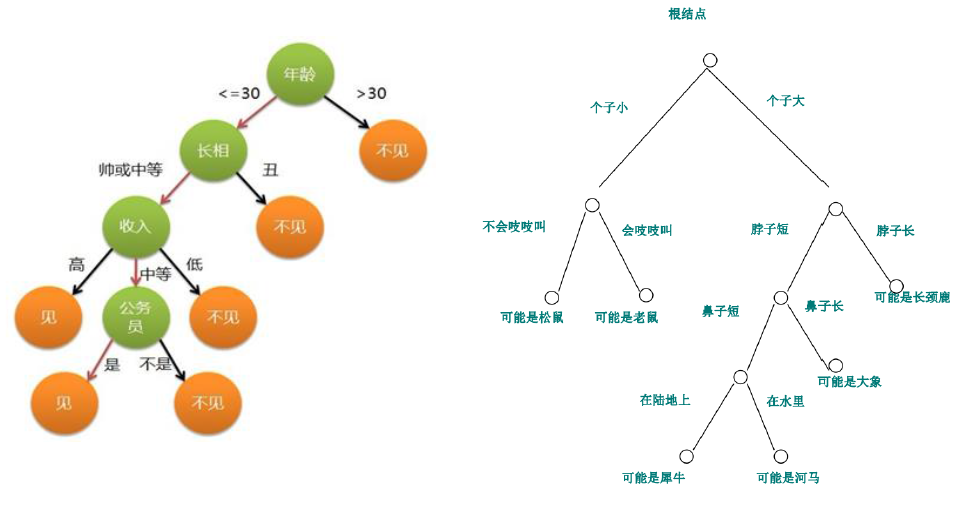TensorFlow与Scikit-learn:决策树算法的机器学习框架集成实战
发布时间: 2024-09-05 00:01:23 阅读量: 131 订阅数: 41 


基于Scikit-Learn和TensorFlow 代码阅读分析.zip

# 1. 决策树算法基础与应用
## 1.1 决策树算法简介
决策树是一种广泛应用于分类和回归任务的监督学习算法。其核心思想是通过一系列的判断规则,将数据集递归地分割成更小的子集,直至每个子集中的数据属于同一个类别或满足某个简单的判断标准。这种算法直观地展示了决策过程,易于理解和解释,是初学者学习机器学习的理想起点。
## 1.2 决策树的工作原理
决策树由节点和有向边组成,节点表示特征或者属性,有向边表示节点值的分支,叶节点代表最终的决策结果或类别。常用的决策树构建方法包括ID3、C4.5和CART算法。构建过程中,算法会根据一定的标准(如信息增益、基尼不纯度)选择最优的特征进行分割,直至满足停止条件。
## 1.3 决策树的应用场景
在实际应用中,决策树算法被广泛用于信用评分、市场细分、医疗诊断和故障预测等领域。其优势在于模型简洁、易于实现和解释性好。例如,在信用卡审批中,决策树可以帮助银行根据申请人的属性(如年龄、收入、信用历史等)快速做出批准或拒绝的决策。通过实际案例分析,本章将深入探讨决策树算法的构建、评估和应用等关键环节,使读者能够全面掌握决策树的理论知识和实践技能。
# 2. TensorFlow集成决策树算法
## 2.1 TensorFlow简介与环境搭建
### 2.1.1 TensorFlow的基本概念
TensorFlow是由Google开发的开源机器学习库,它被设计为支持广泛的深度学习模型和算法。TensorFlow的核心是一个基于数据流图的计算模型,其中节点表示数学运算,而边则表示在这些节点之间传递的多维数组数据(称为“张量”)。TensorFlow提供了丰富的API,可以用于构建和训练各种深度学习模型,包括神经网络、决策树、卷积神经网络(CNNs)、循环神经网络(RNNs)以及更多。
TensorFlow在工业界和学术界都有广泛的应用,它支持多种平台,从单机到分布式计算,包括CPU、GPU、TPU等。TensorFlow的灵活性使其成为构建复杂机器学习模型的强大工具。其命名中的“Flow”象征着张量在图中的流动。
### 2.1.2 TensorFlow的安装与环境配置
为了使用TensorFlow集成决策树算法,首先需要进行TensorFlow的安装与环境配置。TensorFlow支持多种操作系统,包括Windows、Linux、macOS等,并提供了多种安装选项,如直接使用Python包安装器、通过Anaconda环境安装,或者使用Docker容器。
以下是使用Python包安装器pip进行TensorFlow安装的基本步骤:
```bash
pip install tensorflow
```
对于需要使用GPU加速计算的用户,可以安装TensorFlow的GPU版本:
```bash
pip install tensorflow-gpu
```
在安装完成后,建议使用Python导入TensorFlow,以验证安装是否成功:
```python
import tensorflow as tf
print(tf.__version__)
```
此外,TensorFlow提供了TensorBoard工具,便于模型的可视化和监控。为了使用TensorBoard,可以通过以下命令启动TensorBoard服务:
```bash
tensorboard --logdir=path/to/log-directory
```
TensorBoard将会在默认的Web服务器地址上启动,并提供可视化界面供用户使用。
## 2.2 TensorFlow中的决策树实现
### 2.2.1 构建决策树模型
在TensorFlow中,决策树模型可以通过集成学习库tf.contrib.factorization或者使用更高级的封装库如`tensorflow_decision_forests`来构建。在本小节中,我们将通过一个简单的例子来展示如何使用`tensorflow_decision_forests`构建决策树模型。
首先,需要安装`tensorflow_decision_forests`库:
```bash
pip install tensorflow_decision_forests
```
然后,我们可以用以下代码来构建和训练一个决策树模型:
```python
import tensorflow_decision_forests as tfdf
import pandas as pd
from sklearn.model_selection import train_test_split
# 加载数据集,这里以pandas DataFrame格式举例
data = pd.read_csv("data.csv")
# 划分训练集和测试集
train_ds, test_ds = train_test_split(data, test_size=0.3)
# 构建决策树模型
model = tfdf.keras.RandomForestModel()
# 训练模型
model.fit(train_ds)
# 评估模型
evaluation = model.evaluate(test_ds, return_dict=True)
```
### 2.2.2 训练与评估决策树
在上述代码的基础上,我们可以训练模型并对结果进行评估。评估决策树模型通常包括对模型的准确度、召回率、F1分数等指标的评估。
```python
# 使用训练好的模型进行预测
predictions = model.predict(test_ds)
# 计算并打印模型的准确度
accuracy = model.evaluate(test_ds, return_dict=True)["accuracy"]
print(f"Model accuracy: {accuracy:.4f}")
```
### 2.2.3 超参数的调整与优化
模型的超参数调整是提高模型性能的一个重要环节。在TensorFlow中,我们可以通过调整诸如树的数量、树的深度、学习率等参数来优化决策树模型。
```python
# 设置超参数
model = tfdf.keras.RandomForestModel(
num_trees=100,
max_depth=10,
bootstrap_size_ratio=0.5
)
model.fit(train_ds)
```
通过调整这些参数,我们可以影响模型的性能,例如,增加树的数量可以提高模型的预测精度,但也可能引起过拟合。通过适当的超参数调整,我们可以在模型复杂度和泛化能力之间找到平衡。
## 2.3 TensorFlow决策树的高级应用
### 2.3.1 特征选择与模型复杂度控制
特征选择是机器学习中优化模型的重要步骤之一,它可以帮助减少模型复杂度,提高模型的可解释性,并防止过拟合。TensorFlow提供了多种特征选择方法。
```python
# 使用特征重要性排序进行特征选择
feature_importances = model.make_inspector().feature_importances()
sorted_idx = feature_importances.sort_values(ascending=False).index
# 选择最重要的N个特征进行模型训练
N = 10
top_features = sorted_idx[:N]
model.fit(train_ds.select_dtypes(include=[np.number]).columns[top_features])
```
在上面的代码中,我们使用了`feature_importances`来对特征的重要性进行排序,并选择了最重要的N个特征用于模型训练。
### 2.3.2 模型持久化与部署策略
模型的持久化是指将训练好的模型保存到磁盘上,以便之后的加载和部署。TensorFlow提供了`model.save()`和`keras.models.load_model()`函数来保存和加载模型。
```python
# 保存模型
model.save("my_decision_tree")
# 加载模型
loaded_model = tf.keras.models.load_model("my_decision_tree")
```
加载后的模型可以用于预测新的数据,并且可以部署到生产环境中去。部署策略包括使用TensorFlow Serving进行在线服务部署、通过TensorFlow Lite转换为移动或嵌入式设备等。
```mermaid
graph LR
A[训练好的模型] -->|保存| B[磁盘]
B -->|加载| C[应用部署]
C -->|在线服务| D[TensorFlow Serving]
C -->|移动设备| E[TensorFlow Lite]
```
通过上述流程,我们可以实现决策树模型从训练、保存到应用部署的整个过程。
# 3. Scikit-learn集成决策树算法
## 3.1 Scikit-learn简介与环境搭建
### 3.1.1 Scikit-learn的基本概念
Scikit-learn是一个开源的机器学习库,它提供了一系列简单的工具用于数据挖掘和数据分析。作为Python语言的一个扩展库,Scikit-learn能够提供广泛的监督和非监督学习算法。它包括但不限于分类、回归、聚类算法以及数据降维等常用工具。Scikit-learn的设计哲学以简洁、可重复、易用为宗旨,受到广泛的社区支持和使用。
### 3.1.2 Scikit-learn的安装与环境配置
Scikit-learn的安装非常简单,推荐使用Python包管理工具pip来安装:
```bash
pip install scikit-learn
```
安装完成后,可以使用Python的交互式环境或Jupyter Notebook等工具进行Scikit-learn的环境测试。
```python
from sklearn import __version__
print(__version__)
```
这段代码会打印出当前安装的Scikit-learn版本,从而确认安装成功。
## 3.2 Scikit-learn中的决策树实现
### 3.2.1 构建决策树模型
Scikit-learn中的决策树模型可以通过`DecisionTreeClassifier`(分类)或`DecisionTreeRegressor`(回归)类来实现。以下是一个构建分类决策树模型的示例代码:
```python
from sklearn.tree import DecisionTreeClassifier
fr
```
0
0





